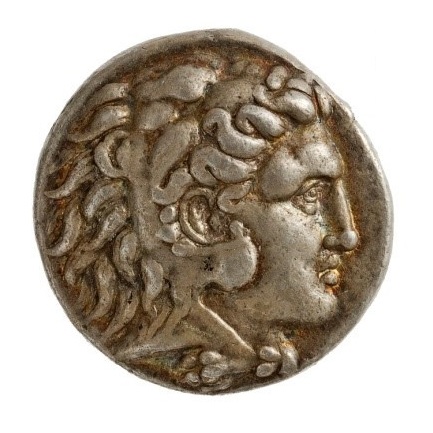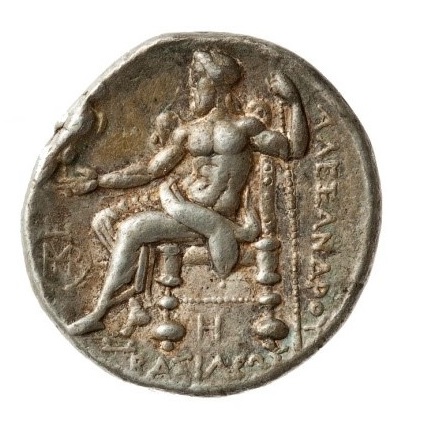Acquisition number: 2006.03
Obv.: Head of Herakles r., wearing a lionskin
Rev.: Zeus seated, holding eagle in right hand and sceptre in left. ΑΛΕΞΑΝΔΡΟΥ ΒΑΣΙΛΕΩΣ (‘of King Alexander’). Monogram in wreath in left field, H below throne.
Posthumous issue of Alexander III of Macedon, struck by Seleukos I Nikator of Syria.
Title: Tetradrachmon struck in the name and types of Alexander III of Makedonia (Macedon) by Seleukos I Nikator - 2006.03
Acquisition number: 2006.03
Author or editor: Hugh Preston
Culture or period: Macedon and Successors
Date: c. 311 - 305 BC.
Material: Metal - Silver
Object type: Coins - Greek
Dimensions: 26mm (w)
Origin region or location: Iraq
Origin city: Babylon.
Display case or on loan: 5
Keywords: Coin, Greek, Macedonian, tetradrachmon, Herakles, Zeus, Alexander, Seleukos
M.J. Price, The Coinage n the Name of Alexander the Great and Philip Arrhidaeus: A British Museum Catalogue (London and Zurich, The British Museum and the Swiss Numismatic Society, 1991), 3742.
O. Hoover, Handbook of Greek Coinage 13 vols (Classical Numismatic Group, Lancaster, PA, 2009-2013), 9, 10f.
2006.03
Tetradrachmon struck in the name and types of Alexander III of Makedonia (Macedon) by Seleukos I Nikator
Silver 16.91 g. 26 mm. 311-305 BC.
Obv.: Head of Herakles r., wearing a lionskin
Rev.: Zeus seated, holding eagle in right hand and sceptre in left. ΑΛΕΞΑΝΔΡΟΥ ΒΑΣΙΛΕΩΣ (‘of King Alexander’). Monogram in wreath in left field, H below throne.
Posthumous issue of Alexander III of Macedon, struck by Seleukos I Nikator of Syria.
Seleukos I was allotted the satrapy of Babylon in 321 BC. He was the longest surviving of the generals who succeeded Alexander despite being ousted temporarily in 316 BC. He proclaimed himself king of an expanded territory in 305 BC. In 301 BC two groups of the Diodochoi (the successors of Alexander the Great came to blows at the Battle of Ipsos. The victorious group comprised Kassandros, ruler of Makedonia, Lysimachos ruler of Thrace; and Seleukos I. In 282 BC Seleukos was invited by Lysimachos to invade parts of western Asia Minor. He was, however, assassinated before he was able to take possession of the territories.
The early silver coinage of Seleukos I was struck with the types of Alexander the Great until 305/4 BC. After that year coins were struck in his name. His large and varied coinage was struck in three metals (gold, bronze and, predominantly, silver) and a number of denominations appropriate to various regions in the kingdom.
Portrait heads did not appear until the reign of his son Antiochos I Soter. The first portrait silver issues appeared early in that reign, c. 275 BC.
Presented to the Classics Museum by Mr Russell Buzby.
Cf. 1967.25 in this collection.
M.J. Price, The Coinage n the Name of Alexander the Great and Philip Arrhidaeus: A British Museum Catalogue (London and Zurich, The British Museum and the Swiss Numismatic Society, 1991), 3742.
O. Hoover, Handbook of Greek Coinage 13 vols (Classical Numismatic Group, Lancaster, PA, 2009-2013), 9, 10f.

